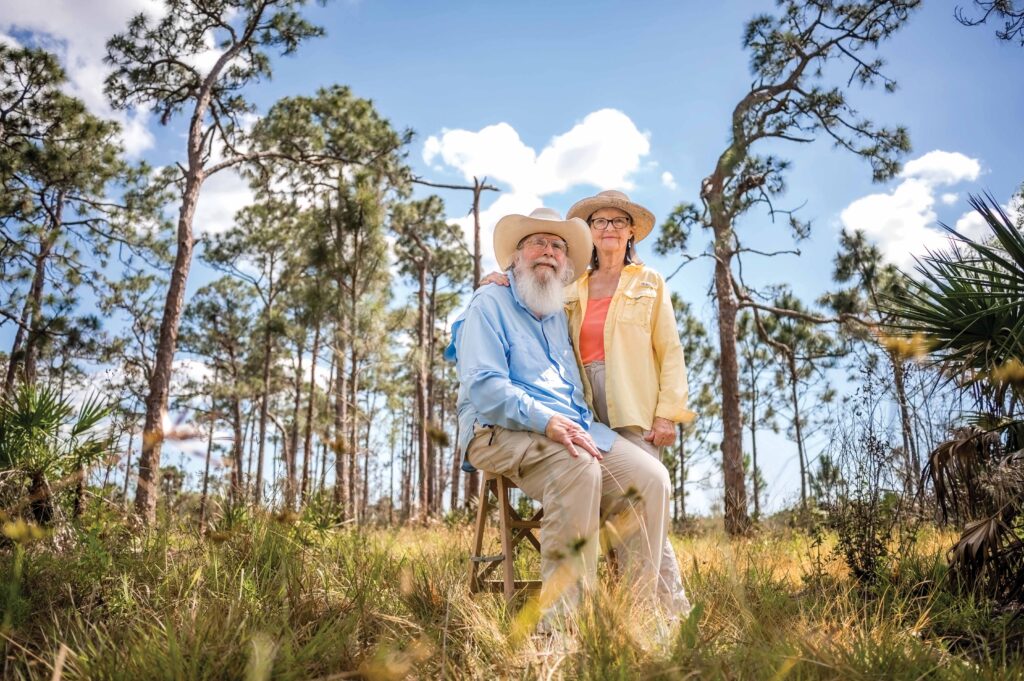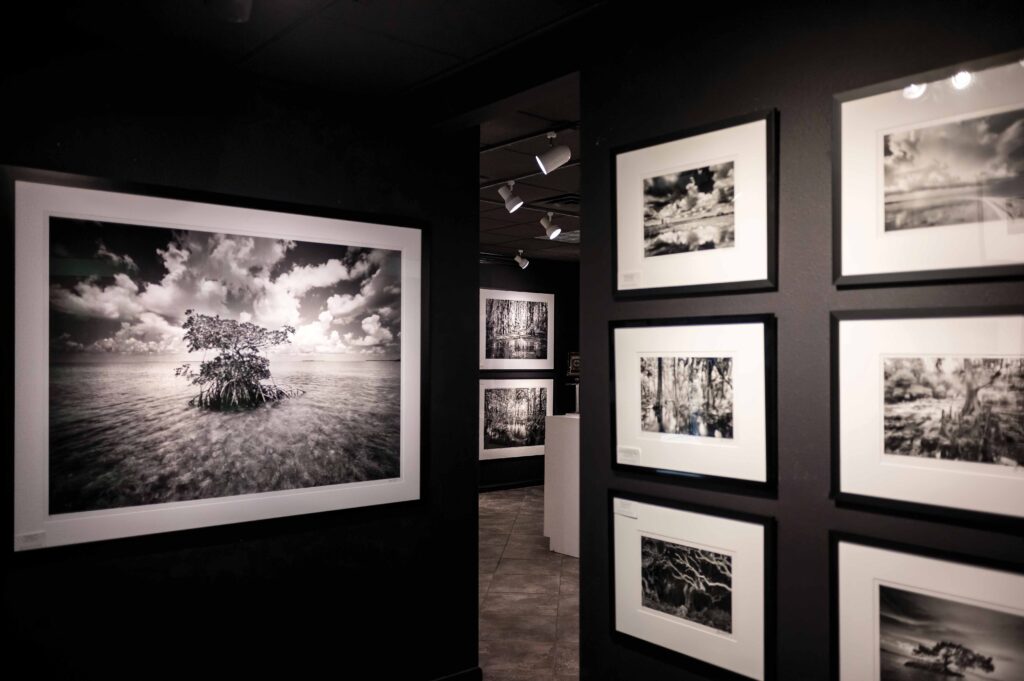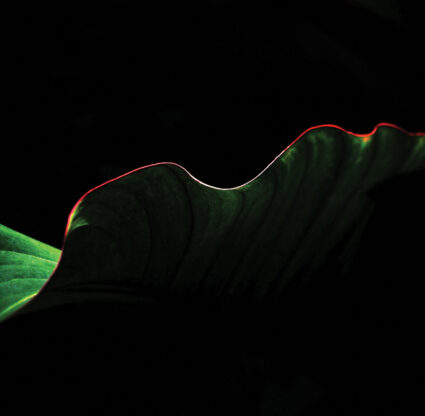Niki Butcher holds a black-and-white photograph at arm’s length against a swampy landscape. We compare the real-life scene to the image her husband, Clyde, the famed Florida wilderness photographer, had taken with his new infrared camera.
“I’m getting excited about this,” Clyde says. The photo is one of about a dozen he’s shot with the device, which measures a wavelength on the infrared spectrum higher than the human eye can see. In this photograph, the whites are so bright they appear glowing, the textures are so pronounced they look 3D. Niki had suggested capturing that spot. “Your eyes are just drawn back there,” she says, gesturing to a distant pop ash tree. Her husband agreed. It was not the first time his wife had detected a thing of beauty and proposed a photograph.
I am happy to see Clyde, at 80 and slowed by a stroke, continue to innovate. But my focus is not on the photograph, the swamp or the techniques Clyde used to capture it. It’s on the couple. Because without Niki, there wouldn’t be a Clyde, and without their daughter, Jackie Butcher Obendorf, there wouldn’t be a thriving business promoting his work, and without Ted, their son lost at 17, the clan might never have ventured into the swamp, discovered its wonders and embarked on a mission to save it. This is a family tale.
“I did not want to have a 9-to-5 life, and since I married Clyde, I have not. Ever,” Niki says.
“She sees the romance in a photo,” Clyde says of Niki.
“She saw that we are not selling a product, we are selling an emotion,” Niki says of Jackie.
“When you guys are out there, you work as a team,” Jackie had said of her parents on a previous afternoon.
Let’s not romanticize, though. The Butchers’ legacy was born of love for each other and the outdoors, but their bonds have been tested many, many times. That’s why they share their story. There are lessons to be gleaned from the family’s success—and their survival.
The home where we meet, the one that inspired Clyde’s best-known work, is nestled in Big Cypress National Preserve, halfway between Naples and Miami. The gallery fronts Tamiami Trail and draws a surprising amount of foot traffic. Their former residence (they live full-time in Venice now) and a couple of guest cottages are tucked behind it. The forest engulfs the structures—pond apple and pop ash trees, ferns and bromeliads, and scattered cypress, survivors of a century-old logging craze.
It was Niki who chose that location. Its previous owner was an orchid vendor, a recluse whose yard sign invited visitors for a $2 fee but who chased off the burly Clyde with a shotgun, growling that he didn’t trust men with beards. A diminutive-looking Niki returned another day, waving dollar bills in plain sight. The man allowed passage. “I walked to the back where our house is now sitting, and I sat on a log,” she remembers. “There were butterflies and dragonflies fluttering around. It was sort of like a Disney movie.” Niki didn’t know the property was for sale but nevertheless imagined a gallery, a home, a place of solitude to heal herself and support Clyde, who retreated from their home in Fort Myers to the swamps to perfect his photography and mourn his son. A drunk driver had stolen Ted six years before.
Niki had long dreamed of living in a forest, though she imagined her native California’s orderly redwoods. Florida’s wilderness, by contrast, is wild, untamed, unpredictable—a little like the Butchers who came of age in the ’60s and embraced the era’s freewheeling ethos. They had fallen in love with the state’s interior a few years earlier, on a chance outing to an old Central Florida roadside attraction that introduced visitors to the beauty of the swamp from the safety of a boardwalk. “It had that amazing feeling that the redwood forest had,” recalls Niki, who had insisted they stop. “That ancient, ancient wisdom.” “Primeval,” Clyde adds. He returned to photograph it a short time later, this time getting his feet wet.
And that is why Clyde said “yes” as soon as Niki discovered the Big Cypress property was on the market. The move to the Everglades was not the first time the couple had retreated to nature. Clyde started his career as a commercial photographer in California, at first pioneering techniques for photographing architecture—his initial field of study—and then specializing in full-color landscapes for mass-produced wall art. Photography wasn’t considered an art form then; he embedded clocks to make the images “functional.” Clyde sold the clocks through retailers such as Sears and J.C. Penney. On paper, the business boomed. The Butchers and their partners managed 70,000 square feet of manufacturing space and more than 200 employees. At one point, the family says, one in 10 households in America owned a Clyde Butcher photo.
The success was an illusion. Clyde’s deep-pocketed partners reinvested their earnings to grow the company; the photographer, who grew up poor, barely scraped by when he tried to match their contributions. The workload was tremendous. Niki was conscripted into management and hated it. “I was lousy. It is not my personality,” she says. Jackie and Ted were preschoolers. “Our marriage was falling apart,” Niki says. “We had a sailboat, and we went out on it one weekend. As we came back, Clyde said, ‘I don’t feel like going back to the apartment.’ And neither did I.” The young family moved aboard, rowing a dinghy to work each morning and sleeping under the stars each night. “It saved our marriage,” Niki says.

They lived that way, on and off, for 10 years without electricity, running water, or the material things that tether so many of us. Jackie and Ted grew up side by side, each other’s company their only constant. They traveled to far-flung photoshoots, once spending a two-month stint in Mexico, until the parents decided their blossoming adolescents needed space and stability. They settled in Fort Myers in 1980. Niki and Clyde’s retelling makes those years sound romantic.
Jackie reflects fondly, too, but she fills in the grim parts: the hostile takeover that forced Clyde out of the clock business, his unsuccessful attempt to start a new company, the family’s bankruptcy, the inconsistency. “I think I went to like 23 different schools before high school,” Jackie says. “My childhood was very chaotic.” Eventually, she would inject order.
It’s not a bad backyard,” Clyde says, as we stare at the swamp. Birds caw overhead, and a light breeze rustles the leaves. It is otherwise quiet. Did they ever feel lonely in those dozen years in the swamp, I ask? They shake their heads. Their relationship was born out of a shared love for nature’s solitude.
Clyde and Niki met while Clyde was a student at California Polytechnic State University and Niki an aspiring photographer. Clyde was dating Niki’s best friend. The pair invited Niki on a double date along with a buddy of Clyde’s. The mismatched couples didn’t last, and Clyde and Niki began seeing each other. Niki hated crowds and was happy to find a man who understood that. “Our first date was in the bleachers at Stanford University,” Clyde remembers. “There was nobody there. We just sat and talked.” They enjoyed long treks on the beach and through the woods, and occasional strolls to the movie theater, savoring the walk more than the film. “We bonded with each other and with nature,” Niki says.
They married when he was 21 and she 19. I wondered how they made it, two kids who started a marriage in a trailer. They would go on to endure their business hardships, the loss of their son, Hurricane Andrew’s rampage through Big Cypress, Clyde’s stroke and its aftermath. “I think we were just kind of stuck. We had to make it work,” Clyde says. His eyes twinkle as he says it. Niki bursts out laughing. Their secret is, of course, much more than that. “Every time you go through something in life, it’s an adventure,” Niki says. “It was hard for me to go through a lot of these difficult times in my life, but … I feel very satisfied about having lived a life that took chances and that had ups and downs. That’s what life is all about. It’s not about staying still.”
Except it did once halt. On June 15, 1986—Niki and Clyde’s wedding anniversary and Father’s Day that year—a drunk driver hit 17-year-old Ted’s car. Jackie knows the exact moment he died; in her college apartment, she had doubled over in agony so extreme her boyfriend called 911. It was not the first time she had experienced her brother’s pain. They were like twins that way.
At the time of Ted’s death, Clyde and Niki made their living on the art fair circuit, Clyde with his full-color photography and Niki with her hand-painted black-and-white photos. Clyde, from the start, had longed to specialize in black-and-white, more so now as he sought to capture the textures and shadows of the swamps. But he worried about paying the bills. “He was about money. If (the photo) sold, it was good. This would sell, that would not,” Niki remembers. “That’s what our business was about.”
After the crash, he retreated to the wilderness, armed with a vintage 8-by-10-inch view camera, determined to pursue his calling and find meaning in tragedy. “I thought everybody has to heal in some way,” Niki says. She, too, was skeptical of black-and-white photography’s marketability. But she assured her husband that she could float the family with her artwork. “I figured he would find out it doesn’t sell, and then he’ll go back to color.” Clyde cuts in, with an I-told-you-so grin, “The best show I ever had was black-and-white—like four times better than my best color show.”
As Clyde fell in love with the Everglades, environmentalists warned that the ecosystem was dying. In 1991, the state passed the Marjory Stoneman Douglas Everglades Protection Act, the precursor to the Comprehensive Everglades Restoration Plan of 2000. Clyde’s large-format photography was a way to take his viewers into the swamps with him and show them what was at stake. “I have talked to politicians that have said without my work, they couldn’t have done that restoration,” Clyde says. “Because before they saw it … they didn’t understand the importance of it, the beauty of it. It was just a swamp.”
“Come here, I want to show you something,” Niki says. She leads me to the front of the property and points to a utility pole by the gallery’s facade. She’d first noticed the identification number affixed to it shortly after she and Clyde bought the property. T11786. T = Ted. 1 = their only son. 17 = his age at death. 86 = the year he was killed. The couple dubbed the place “Loose Screw Sanctuary,” their good-humored response to friends who called them crazy for running a business out there. But she knew they had landed right where they were supposed to be.
Jackie always had a head for business. Once the family settled in Fort Myers, she enrolled in Riverdale High School and joined a student entrepreneurship club. The group entered a competition requiring students to conceive a company and write its business plan. She doesn’t remember her invented venture, but she does remember long hours with her dad, discussing matters of profit margins and operating expenses. She advanced all the way to the national championship.
Ted died the summer following her first year of college. Jackie came home. “We let her drift for about six months,” Niki remembers. As the January term neared, Niki urged her to re-enroll. Jackie declined, uncertain of her future. Niki asked her to imagine what she would be doing had she graduated. “Run my own business,” Jackie responded. Clyde interjected, “Then, let’s start you a business!”
Jackie began a wholesale operation selling postcards and greeting cards of her mom’s art. Her company, in time, expanded to include a line of resort wear. She married and settled in Venice, her husband’s hometown. She insisted on putting down deep, immovable roots. From a distance, Jackie recognized Clyde’s growing popularity but did not yet realize his impact. “I knew my dad was famous, and I knew he was doing important stuff, and I would go to the gallery, but I really wasn’t involved in the business,” she says.

By the late 1990s, Jackie’s business had swelled into a workforce of 45. She purchased a building in a Venice industrial district. After becoming pregnant with her second child, she pined for more time at home and butted heads with the big retailers that sold her products. Meanwhile, her dad’s photography business suffered from the logistics of shuttling between the Big Cypress gallery and Jackie’s Venice warehouse, where she’d outfitted a darkroom, and from employees who took advantage of Clyde and Niki’s managerial leniency. “They are really good at being artists. I’m really good at running a business,” Jackie says. She adds, “I grew up with starving artists. And I didn’t want to be that when I grew up.”
She told her parents she wanted out of her business and into theirs. They agreed. “We call her our mother,” Niki murmurs to me one day. Jackie is the firstborn, the daughter, the surviving child. She’s also a master tactician, whom Niki credits for the business’ shift in fortune. Jackie learned the art market and elevated Clyde’s prices, attracting more buyers as serious collectors started taking Clyde Butcher—and the art of photography—more seriously. She magnified his art’s conservation message by working with her mom, who insisted Clyde publish books, and curating museum exhibitions. One exhibit, America’s Everglades: Through the Lens of Clyde Butcher, includes extended interpretive panels that explain the ecological wonders of the ’Glades and the imperative to restore it. “As I came into the business, I thought, ‘You know, he’s really making a difference.’ This is not just a business,” Jackie reflects.
Jackie was attuned to something else, too: Niki’s influence. “Most black-and-white photographs are either masculine or feminine,” Jackie says. “But he’s one of the few photographers I’ve seen in black and white that both women and men like. I think it’s because they photograph together … So even though he’s behind the lens, she is, too.”
We’re at the Venice gallery, Jackie’s former warehouse. She displays her favorite pieces here, primarily images from her parents’ Big Cypress years. “In that one, they were together,” she says, pointing to an image. “In that one, they were together.” She ticks through several more. “My dad is good with space. My mom is good with composition. So, my dad will see a space, and my mom will compose it.” Or, as Niki puts it on another occasion: “We’ve been married 59 years. We are very good at backseat driving each other.”
Jackie intends for the business to remain in the family. Clyde’s speaking contracts list her as his stand-in should he feel unwell. Jackie’s husband, Neal Obendorf, is Clyde’s longtime darkroom technician—the person behind those oversized, meticulously printed photographs. Their daughter, Kayla, is an aspiring artist; their son, Robert, a tech whiz. Jackie will let them find their own paths, but she suspects in time they will involve themselves in the family cause.
Jackie is studying environmental issues so that she can speak to them with authority, like her dad. “I’m (now) doing things like Facebook Live and putting my face out there. I feel the public needs to know this is a family business,” she says. “I am close to my dad. I love my dad. I love his art. I want to keep this going, so it doesn’t end with him.”
The sun slants lower in the swamp. Clyde had gladly indulged my wish to see the spot of his new infrared image, but now his knees ache. Before she brings her husband back to their cottage, Niki turns to me. “There are two inspirations that I would like this story to have for people. One, that if you lose a child, you choose to honor your child. For us, we honored our child through the environment,” Niki says. The other? To chase a dream, no matter your age. “We did not become a success in doing what we love to do until we were in our 50s. Learn from your trials and just keep working at it. People give up. If you don’t give up, you will be one of three or four people left who succeed.” Clyde overhears us and weighs in: “A lot of people get depressed. They give up on life. We took it and tried to do something positive with it.” A mission accomplished. Together.



